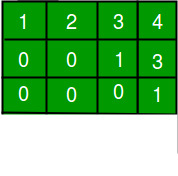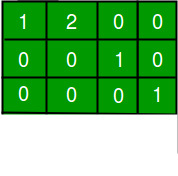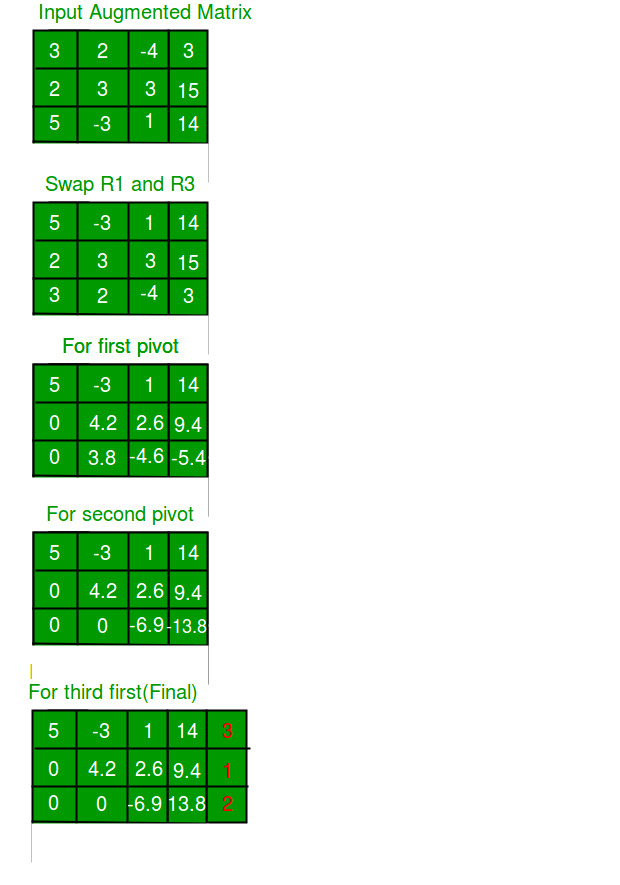本文概述
这篇文章着重于用一种算法来求解线性方程组。我们将处理系数矩阵。高斯消去对奇异矩阵不起作用(它们导致除零)。
Input: For N unknowns, input is an augmented
matrix of size N x (N+1). One extra
column is for Right Hand Side (RHS)
mat[N][N+1] = {{3.0, 2.0, -4.0, 3.0}, {2.0, 3.0, 3.0, 15.0}, {5.0, -3, 1.0, 14.0}
};
Output: Solution to equations is:
3.000000
1.000000
2.000000
Explanation:
Given matrix represents following equations
3.0X1 + 2.0X2 - 4.0X3 = 3.0
2.0X1 + 3.0X2 + 3.0X3 = 15.0
5.0X1 - 3.0X2 + X3 = 14.0
There is a unique solution for given equations, solutions is, X1 = 3.0, X2 = 1.0, X3 = 2.0, 
行阶梯形:如果满足以下条件,则称矩阵处于r.e.f.中:
- 每行中的第一个非零元素(称为前导系数)为1。
- 每个前导系数位于前一行前导系数右侧的一栏中。
- 具有全零的行位于具有至少一个非零元素的行的下方。

简化的行阶梯形形式:
据说Matrix位于r.r.e.f.如果符合以下条件, 则–
- r.e.f.的所有条件
- 每行中的前导系数是其列中唯一的非零条目。
该算法主要是关于在矩阵的行上执行一系列操作。在执行这些操作时, 我们要记住的是, 我们希望将矩阵转换为行阶梯形形式的上三角矩阵。操作可以是:
- 交换两行
- 将行乘以非零标量
- 将另一行的倍数添加到一行
过程:
- 向前消除:简化为行阶梯形形式。使用它可以告诉你是否存在解决方案, 唯一解决方案或无限多个解决方案。
- 反向替换:进一步简化为简化的行阶梯形形式。
算法:
- 部分枢轴:通过交换行来查找第k个枢轴, 以将绝对值最大的条目移动到枢轴位置。这使算法具有计算稳定性。
- 对于枢轴以下的每一行, 计算使第k个条目为零的因子f, 并为该行中的每个元素减去第k行中相应元素的f倍。
- 对每个未知重复上述步骤。我们将获得部分R.e.f.矩阵。
下面是上述算法的实现。
C
// C++ program to demonstrate working of Guassian Elimination
// method
#include<bits/stdc++.h>
using namespace std;
#define N 3 // Number of unknowns
// function to reduce matrix to r.e.f. Returns a value to
// indicate whether matrix is singular or not
int forwardElim( double mat[N][N+1]);
// function to calculate the values of the unknowns
void backSub( double mat[N][N+1]);
// function to get matrix content
void gaussianElimination( double mat[N][N+1])
{
/* reduction into r.e.f. */
int singular_flag = forwardElim(mat);
/* if matrix is singular */
if (singular_flag != -1)
{
printf ( "Singular Matrix.\n" );
/* if the RHS of equation corresponding to
zero row is 0, * system has infinitely
many solutions, else inconsistent*/
if (mat[singular_flag][N])
printf ( "Inconsistent System." );
else
printf ( "May have infinitely many "
"solutions." );
return ;
}
/* get solution to system and print it using
backward substitution */
backSub(mat);
}
// function for elementary operation of swapping two rows
void swap_row( double mat[N][N+1], int i, int j)
{
//printf("Swapped rows %d and %d\n", i, j);
for ( int k=0; k<=N; k++)
{
double temp = mat[i][k];
mat[i][k] = mat[j][k];
mat[j][k] = temp;
}
}
// function to print matrix content at any stage
void print( double mat[N][N+1])
{
for ( int i=0; i<N; i++, printf ( "\n" ))
for ( int j=0; j<=N; j++)
printf ( "%lf " , mat[i][j]);
printf ( "\n" );
}
// function to reduce matrix to r.e.f.
int forwardElim( double mat[N][N+1])
{
for ( int k=0; k<N; k++)
{
// Initialize maximum value and index for pivot
int i_max = k;
int v_max = mat[i_max][k];
/* find greater amplitude for pivot if any */
for ( int i = k+1; i < N; i++)
if ( abs (mat[i][k]) > v_max)
v_max = mat[i][k], i_max = i;
/* if a prinicipal diagonal element is zero, * it denotes that matrix is singular, and
* will lead to a division-by-zero later. */
if (!mat[k][i_max])
return k; // Matrix is singular
/* Swap the greatest value row with current row */
if (i_max != k)
swap_row(mat, k, i_max);
for ( int i=k+1; i<N; i++)
{
/* factor f to set current row kth element to 0, * and subsequently remaining kth column to 0 */
double f = mat[i][k]/mat[k][k];
/* subtract fth multiple of corresponding kth
row element*/
for ( int j=k+1; j<=N; j++)
mat[i][j] -= mat[k][j]*f;
/* filling lower triangular matrix with zeros*/
mat[i][k] = 0;
}
//print(mat); //for matrix state
}
//print(mat); //for matrix state
return -1;
}
// function to calculate the values of the unknowns
void backSub( double mat[N][N+1])
{
double x[N]; // An array to store solution
/* Start calculating from last equation up to the
first */
for ( int i = N-1; i >= 0; i--)
{
/* start with the RHS of the equation */
x[i] = mat[i][N];
/* Initialize j to i+1 since matrix is upper
triangular*/
for ( int j=i+1; j<N; j++)
{
/* subtract all the lhs values
* except the coefficient of the variable
* whose value is being calculated */
x[i] -= mat[i][j]*x[j];
}
/* divide the RHS by the coefficient of the
unknown being calculated */
x[i] = x[i]/mat[i][i];
}
printf ( "\nSolution for the system:\n" );
for ( int i=0; i<N; i++)
printf ( "%lf\n" , x[i]);
}
// Driver program
int main()
{
/* input matrix */
double mat[N][N+1] = {{3.0, 2.0, -4.0, 3.0}, {2.0, 3.0, 3.0, 15.0}, {5.0, -3, 1.0, 14.0}
};
gaussianElimination(mat);
return 0;
}的PHP
<?php
// PHP program to demonstrate working
// of Guassian Elimination method
$N = 3; // Number of unknowns
// function to get matrix content
function gaussianElimination( $mat )
{
global $N ;
/* reduction into r.e.f. */
$singular_flag = forwardElim( $mat );
/* if matrix is singular */
if ( $singular_flag != -1)
{
print ( "Singular Matrix.\n" );
/* if the RHS of equation corresponding to
zero row is 0, * system has infinitely
many solutions, else inconsistent*/
if ( $mat [ $singular_flag ][ $N ])
print ( "Inconsistent System." );
else
print ( "May have infinitely many solutions." );
return ;
}
/* get solution to system and print it using
backward substitution */
backSub( $mat );
}
// function for elementary operation
// of swapping two rows
function swap_row(& $mat , $i , $j )
{
global $N ;
//printf("Swapped rows %d and %d\n", i, j);
for ( $k = 0; $k <= $N ; $k ++)
{
$temp = $mat [ $i ][ $k ];
$mat [ $i ][ $k ] = $mat [ $j ][ $k ];
$mat [ $j ][ $k ] = $temp ;
}
}
// function to print matrix content at any stage
function print1( $mat )
{
global $N ;
for ( $i =0; $i < $N ; $i ++, print ( "\n" ))
for ( $j =0; $j <= $N ; $j ++)
print ( $mat [ $i ][ $j ]);
print ( "\n" );
}
// function to reduce matrix to r.e.f.
function forwardElim(& $mat )
{
global $N ;
for ( $k =0; $k < $N ; $k ++)
{
// Initialize maximum value and index for pivot
$i_max = $k ;
$v_max = $mat [ $i_max ][ $k ];
/* find greater amplitude for pivot if any */
for ( $i = $k +1; $i < $N ; $i ++)
if ( abs ( $mat [ $i ][ $k ]) > $v_max )
{
$v_max = $mat [ $i ][ $k ];
$i_max = $i ;
}
/* if a prinicipal diagonal element is zero, * it denotes that matrix is singular, and
* will lead to a division-by-zero later. */
if (! $mat [ $k ][ $i_max ])
return $k ; // Matrix is singular
/* Swap the greatest value row with current row */
if ( $i_max != $k )
swap_row( $mat , $k , $i_max );
for ( $i = $k + 1; $i < $N ; $i ++)
{
/* factor f to set current row kth element to 0, * and subsequently remaining kth column to 0 */
$f = $mat [ $i ][ $k ]/ $mat [ $k ][ $k ];
/* subtract fth multiple of corresponding kth
row element*/
for ( $j = $k + 1; $j <= $N ; $j ++)
$mat [ $i ][ $j ] -= $mat [ $k ][ $j ] * $f ;
/* filling lower triangular matrix with zeros*/
$mat [ $i ][ $k ] = 0;
}
//print(mat); //for matrix state
}
//print(mat); //for matrix state
return -1;
}
// function to calculate the values of the unknowns
function backSub(& $mat )
{
global $N ;
$x = array_fill (0, $N , 0); // An array to store solution
/* Start calculating from last equation up to the
first */
for ( $i = $N - 1; $i >= 0; $i --)
{
/* start with the RHS of the equation */
$x [ $i ] = $mat [ $i ][ $N ];
/* Initialize j to i+1 since matrix is upper
triangular*/
for ( $j = $i + 1; $j < $N ; $j ++)
{
/* subtract all the lhs values
* except the coefficient of the variable
* whose value is being calculated */
$x [ $i ] -= $mat [ $i ][ $j ] * $x [ $j ];
}
/* divide the RHS by the coefficient of the
unknown being calculated */
$x [ $i ] = $x [ $i ] / $mat [ $i ][ $i ];
}
print ( "\nSolution for the system:\n" );
for ( $i = 0; $i < $N ; $i ++)
print (number_format( strval ( $x [ $i ]), 6). "\n" );
}
// Driver program
/* input matrix */
$mat = array ( array (3.0, 2.0, -4.0, 3.0), array (2.0, 3.0, 3.0, 15.0), array (5.0, -3, 1.0, 14.0));
gaussianElimination( $mat );
// This code is contributed by mits
?>输出如下:
Solution for the system:
3.000000
1.000000
2.000000插图:

时间复杂度:由于对于每个枢轴, 我们遍历该零件在其下面的每一行的右侧, 因此O(n)*(O(n)* O(n))= O(n3)。
我们还可以应用高斯消去法来计算:
- 矩阵的等级
- 矩阵的行列式
- 可逆方阵的逆
本文作者:Yash Varyani。如果发现任何不正确的地方, 或者想分享有关上述主题的更多信息, 请写评论。

![从字法上最小长度N的排列,使得对于正好为K个索引,a[i] a[i]+1](https://www.lsbin.com/wp-content/themes/begin%20lts/img/loading.png)